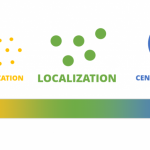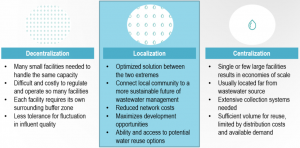What Is Localization?
or What Do Goldilocks and Wastewater Management Have in Common?
by Matthew Kuzma, Vice President – Technical Solutions of Organica Water
Getting Wastewater Management “Just Right”
Most of you know the story of Goldilocks and her porridge. First, it was “too hot”, then it was “too cold”, but ultimately she found the last bowl to be “just right”. Similarly, many of us in the wastewater industry struggle to find “just right” in our efforts to balance the two extremes of “centralization” and “de-centralization”. We’ll analyze the good and bad of both options, but first we should define what each end of the centralization spectrum means.
As commonly applied in many metropolitan areas, “centralized” wastewater management essentially employs large networks of sewer lines to collect and transport the wastewater to a large facility outside of town. While not clearly defined anywhere, the end of the centralization spectrum would have 100% of the community wastewater treated in a single facility. Alternately, other communities utilize the other extreme, with minimal collection networks and treatment at either the individual home or small clusters of a few homes, leading to a “de-centralized” approach.
Of course, both options have benefits and drawbacks. Factors that should be considered include many cost and operational reliability items, but should not be limited only to the treatment facility. In this analysis, we have to look at the OVERALL cost and impacts of wastewater management, not solely the cost of wastewater treatment. With this wider lens, the impacts of centralization vs. decentralization should, of course, include treatment, but also collection systems, residuals (biosolids) management, land requirements, carbon footprint, ability to reuse the reclaimed water, and regulatory impacts. While not comprehensive, these are the areas that have the most impact on the comparison. Let’s look at each of these areas individually:
Cost of constructing, operating, and maintaining treatment facilities
As should be obvious, there are economies of scale that apply in both the cost of constructing treatment facilities as well as operating and maintaining those facilities once constructed (on a cost per unit treated scale). Certainly a facility built to treat 100,000 m3 per day (roughly 25 million gallons per day) of wastewater will not cost twice as much as a facility to treat 50,000 m3 per day to the same standards, with savings in instruments, equipment, engineering and other costs that don’t scale linearly. Further, this is also true for the operational costs in labor and staffing, as well as commonly applied tools to reduce energy use that incur more attractive paybacks as the scale increases. As a result, a centralized approach will nearly always result in the lowest cost per unit treated.
Cost of constructing, operating, and maintaining sewer networks
As the other largest component of the costs incurred, the collection system including sewer pipe networks and pumping stations is greatly impacted by the approach. In contrast to the treatment facilities, the decentralized approach will have the lowest cost of collection costs, both in terms of collection piping and energy use for pumping stations. It is worth mentioning here that in many Western countries, analyses have shown that nearly 90% of the total cost of wastewater management is in the collection system, with only 10% of the cost incurred through treatment of the wastewater. However, it is not quite as simple as only looking at the collection system. As we discuss below in the water reuse analysis, there has to be a way to move the treated wastewater away from the point of treatment. Some water can be reused, and may be relatively easy to discharge in rural areas with low population densities, but in urban or suburban locations the costs of moving the wastewater treated at the individual home to a point of discharge may incur nearly the same costs and impacts as collecting untreated wastewater.
Ability and access to potential water reuse options
As mentioned in the previous point, the ability to utilize reclaimed water from treatment should be considered in all analyses looking at a sustainable future. While some areas are now being forced to consider (or implement) potable reuse solutions (see previous post), this is a relatively unlikely scenario for the vast majority of the global population. Most reasonable analyses of the net water balance for any situation will require some water to be discharged from the individual home and utilized elsewhere for full benefit. Generally, this involves common reuse options such as land irrigation, cooling, boilers (or other heating options), or other industrial uses. In order to utilize the water efficiently, there needs to be enough “economy of scale” (as mentioned above in the treatment costs) – essentially, you have to collect enough reclaimed water to make it worthwhile to the user of that water. This, of course, depends on the use where individual industrial users or irrigation users have limited demand for the reclaimed water. If you think about a major metropolitan area, there are only so many parks, golf courses, or other non-agricultural users of irrigation water the population to land ratio limits the space available to irrigate (of course, if we can start to practice more urban farming, this could improve somewhat). Of course, a centralized treatment plan for reuse will have limitations that result from the cost of distributing a large volume of water in a separate pipe network. But also, a decentralized plan would have limited benefit as there is not enough volume in any individual reclaimed stream to provide the benefit to outweigh the costs. The result is an “inverted” bell curve with the costs at either end being higher than in a middle ground.
Cost and complexity of regulating water discharges
For any wastewater management scheme, whether it includes reuse or discharge to the environment, there will be regulatory costs incurred for water quality sampling, lab analysis, and reporting to the appropriate regulatory authorities. In simplicity, this cost could arguably be included in the costs of treatment as they don’t scale linearly. As an example, the cost of taking an individual discharge water sample, testing it in the lab for the appropriate parameters, and reporting those results are essentially the same for any size facility. Furthermore, there are significant costs to the regulatory agencies in maintaining the appropriate certification, permit compliance, and monitoring infrastructure. As a result, the costs for regulatory management are significantly higher in a decentralized approach.
Ability to manage residuals (and employ beneficial reuse)
With any management scenario, there will be residual waste streams of biosolids as well as non-degradable components (think about grit, plastics, etc. that can enter a collection system) that will require disposal either to a landfill, an incinerator, or potential reuse as a beneficial biosolid. In any case, the costs of managing those residuals will increase as you lose the economies of scale provided by a centralized management scheme. Some costs, such as landfilling of non-beneficial residuals can scale somewhat linearly. However, only when you reach significant scale can some beneficial options such as composting, digestion for energy recovery, nutrient recovery, and even emerging areas such as biopolymer production and metals recovery etc. begin to be both technically and economically feasible. Further, many of the costs of regulatory compliance that apply to water discharges are further exacerbated in the residuals management areas. Often, smaller operations may not be able to justify the costs of testing and compliance management required to reuse the residual biosolids as a beneficial fertilizer. As a result, analysis of this sector of the industry results in a step change in costs; unless you reach a minimum threshold of capacity, the sustainable practices of the future simply don’t make economic or technical sense.
Land requirements for both treatment facilities and pumping stations
Of course, when considering the space requirements for both options, there are impacts in land requirements for both treatment facilities and pumping stations to move either treated or untreated wastewater around the overall system. For the treatment process, several of the components such as treatment process volumes, solids separation options (clarifiers), and other key equipment are driven nearly linearly in their space requirements. However, much of the mechanical equipment involved (pre-treatment screens, pumps, blowers, etc.) will offer significant space savings as the size of the equipment increasing (such as building space required for a pump relative to the capacity of such pumps). Further, quite often the buffer zone required around the facility in “unusable” space is regulated from the outside boundary of the facility. So that a facility that is 50m x 50m (for 2500 m2) will require a buffer zone of 250m in all directions, making it 300m x 300m (90,000 m2) and thus resulting in a massive increase in space required. As such, this buffer zone requirement means that the “wasted” land in the buffer zone is impacted more by the number of treatment facilities you have in place, and not by the size of the individual facilities. For the pumping stations and collection network, however, many times these facilities have significantly reduced requirements for buffer zones and thus consume less space than treatment facilities. Of course, if you can manage the buffer zones differently (for example by designing a treatment facility that does not require such large buffer zones), this analysis could change significantly.
The net result of adding all of these components can also change quite significantly by the location of the analysis. Each individual case may be impacted by local variability in civil construction costs (meaning that treatment facility construction costs and/or pipe network costs are lower), power costs (high power costs push against collection systems with lots of pumping stations), land values (changing the economics of buffer zones or local treatment facilities), costs of residuals disposal (lower costs mean that centralized management creates less value), labor costs (lower labor costs reduce the “economy of scale” seen in centralized treatment operations), and the list goes on. In the end, this simply means that “just right” may not be the same in all locations or situations. It just means that all of these factors need to be included.
But, in this context we would like to introduce a new terminology, generally described as “localized” wastewater management. It’s not decentralized to the point of diminishing returns, but more accurately described as “local” wastewater management that balances the benefits of moving away from large “central” facilities to allow the best capitalization on reduced network costs, enhanced reuse opportunities, and connecting the local community to a more sustainable future of wastewater management. To slightly modify the common phrase of “think globally, act locally”, we should encourage everyone to “think globally, treat locally”, recognizing that “local” treatment will be very different in urban Jakarta, with a population 10 million or more, than Hobart (Tasmania) with a population of 50,000. Though each situation is different, each is impacted by many of the same components to be analyzed. But “just right” balances all of the component to reach the right “local” solution…



